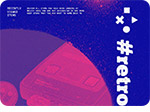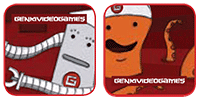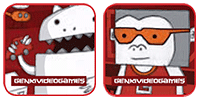PC Engine History & Compatability Guide
Japanese electronics giant NEC released the PC Engine HE System (known as the Turbo Grafx in the US) initially in 1987. The Engine utilised credit card size Hu Cards as the storage format for games.
Grandiose plans for it to be the hub of a home entertainment system incorporating a keyboard, printer and disk drive were thankfully shelved to concentrate on games. It was the release of quality titles from Hudson Soft and Irem (in particular 'R Type') that really got the Engine purring. This snowballed bringing the quality of Namco and Taito on board and leading to the release of the unprecedented add on CD Rom unit.
The PC Engine Core Grafx was released in late 1989 - essentially a PC Engine with AV port different colour scheme, later to be followed up by the Core Grafx 2: again changes were purely cosmetic besides the AV port.
This was followed up in 1990 by the release of the Super Grafx - a larger, souped up Engine with a superb version of 'Ghouls and Ghosts'. Unfortunately only six games were released for the system: Alydnes, Battle Ace, Darius Plus, Ghouls and Ghosts, Granzort and 1941. Whilst the system is fully compatible with PC Engine Hu Cards, Super Grafx titles will only work on the Super Grafx. NEC followed up with the release of the PC Engine Shuttle designed for younger players, but the higher price put many potential gamers off. It was also lacking in any CD Rom connector ports making it Hu Card only.
CD ROM - 1988 saw the first CD Rom unit released for any console in the form of the PC Engine CD Rom. This connected up to the PC Engine base unit working in parallel together.
The Super CD Rom unit was released soon afterwards with rear connectivity and added processing power. As was a Super System Card increasing load speed and buffer memory, allowing those with the standard CD Rom unit to be able to play the new Super CD Rom format.
The PC Engine Duo combined the standard Engine and CD Rom unit negating the need for system cards. It can also play Super CD games too. The Duo R changes were again mainly cosmetic although slightly more substantial than previous updates: more rounded, streamline shape, change to white in colour and cost cutting measures of removing the headphone, expansion port and battery pack connector. Whilst being Genki's 'playtest' machine (^^), the Duo R unfortunately only has one joypad port therefore requires a multitap for multi-player Bomberman mayhem. The very last Engine compatible machine was the Duo RX released in 1994 which came with six button controller.
Further system cards in the shape of the Arcade Card were released: one version to boost the Duo up to arcade grade performance, another to do the same for the standard PC Engine/CD Rom combination thereby containing the system card too. Gaming legend has it that a fire delayed the launch of the Arcade Card and undermimed its level of support. But a high release price did nothing to help.
Imported PC Engines are designed to run on the Japanese standard NTSC television, also used in America. This means for it to work in the UK, the television needs to be NTSC compatible. Most modern TV's will have this NTSC mode capability, but if in doubt please review the TV's manual. Japanese software will not play on a US Turbo Grafx system without a convertor, yet PC Engine Duo's will play CD's from both Japan and the USA.
Handhelds - The PC Engine GT (or Turbo Express as it was called Stateside) is a handheld version of the Engine utilising NEC's expertise in the field of LCD screens. Fully compatible with Hu Cards meaning it benefits from a vast library for a handheld. It can also be connected to a TV using the connector cable. The PC Engine LT has a gorgeously detailed 12cm screen and elitist price being released at 99,950 Yen! Its lack of battery supply and size makes it more like a laptop Engine than a true handheld. It remains today the Rolls Royce of the laptop world - essential desert island hardware.
PC Engine FX - Powerful CD based unit released late in 1994, the FX attracted plenty of anime stylised cartoon adventures with some real classics hidden away. Not compatible with previous PC Engine software.
With approaching seven hundred games released for its various formats over the years and so many diverse genres, PC Engine - we salute you!
Many thanks to Mr. Richard Gibbs for his permission to use his seminal PC Engine Guide Book to help us negotiate the minefield of the PC Engine's history.
Japanese electronics giant NEC released the PC Engine HE System (known as the Turbo Grafx in the US) initially in 1987. The Engine utilised credit card size Hu Cards as the storage format for games.
Grandiose plans for it to be the hub of a home entertainment system incorporating a keyboard, printer and disk drive were thankfully shelved to concentrate on games. It was the release of quality titles from Hudson Soft and Irem (in particular 'R Type') that really got the Engine purring. This snowballed bringing the quality of Namco and Taito on board and leading to the release of the unprecedented add on CD Rom unit.
The PC Engine Core Grafx was released in late 1989 - essentially a PC Engine with AV port different colour scheme, later to be followed up by the Core Grafx 2: again changes were purely cosmetic besides the AV port.
This was followed up in 1990 by the release of the Super Grafx - a larger, souped up Engine with a superb version of 'Ghouls and Ghosts'. Unfortunately only six games were released for the system: Alydnes, Battle Ace, Darius Plus, Ghouls and Ghosts, Granzort and 1941. Whilst the system is fully compatible with PC Engine Hu Cards, Super Grafx titles will only work on the Super Grafx. NEC followed up with the release of the PC Engine Shuttle designed for younger players, but the higher price put many potential gamers off. It was also lacking in any CD Rom connector ports making it Hu Card only.
CD ROM - 1988 saw the first CD Rom unit released for any console in the form of the PC Engine CD Rom. This connected up to the PC Engine base unit working in parallel together.
The Super CD Rom unit was released soon afterwards with rear connectivity and added processing power. As was a Super System Card increasing load speed and buffer memory, allowing those with the standard CD Rom unit to be able to play the new Super CD Rom format.
The PC Engine Duo combined the standard Engine and CD Rom unit negating the need for system cards. It can also play Super CD games too. The Duo R changes were again mainly cosmetic although slightly more substantial than previous updates: more rounded, streamline shape, change to white in colour and cost cutting measures of removing the headphone, expansion port and battery pack connector. Whilst being Genki's 'playtest' machine (^^), the Duo R unfortunately only has one joypad port therefore requires a multitap for multi-player Bomberman mayhem. The very last Engine compatible machine was the Duo RX released in 1994 which came with six button controller.
Further system cards in the shape of the Arcade Card were released: one version to boost the Duo up to arcade grade performance, another to do the same for the standard PC Engine/CD Rom combination thereby containing the system card too. Gaming legend has it that a fire delayed the launch of the Arcade Card and undermimed its level of support. But a high release price did nothing to help.
Imported PC Engines are designed to run on the Japanese standard NTSC television, also used in America. This means for it to work in the UK, the television needs to be NTSC compatible. Most modern TV's will have this NTSC mode capability, but if in doubt please review the TV's manual. Japanese software will not play on a US Turbo Grafx system without a convertor, yet PC Engine Duo's will play CD's from both Japan and the USA.
Handhelds - The PC Engine GT (or Turbo Express as it was called Stateside) is a handheld version of the Engine utilising NEC's expertise in the field of LCD screens. Fully compatible with Hu Cards meaning it benefits from a vast library for a handheld. It can also be connected to a TV using the connector cable. The PC Engine LT has a gorgeously detailed 12cm screen and elitist price being released at 99,950 Yen! Its lack of battery supply and size makes it more like a laptop Engine than a true handheld. It remains today the Rolls Royce of the laptop world - essential desert island hardware.
PC Engine FX - Powerful CD based unit released late in 1994, the FX attracted plenty of anime stylised cartoon adventures with some real classics hidden away. Not compatible with previous PC Engine software.
With approaching seven hundred games released for its various formats over the years and so many diverse genres, PC Engine - we salute you!
Many thanks to Mr. Richard Gibbs for his permission to use his seminal PC Engine Guide Book to help us negotiate the minefield of the PC Engine's history.
Some Other New Arrivals See All
Fighters Megamix (New) - Sega Saturn - £29.99
Marvel Super Heroes - Sega Saturn - £49.99
Momotaro Douchuuki - Sega Saturn - £14.99
Sim City 2000 - Sega Saturn - £12.99
Hanako San - Sega Saturn - £12.99
Dynamite Deka - Sega Saturn - £51.99
Gun Griffon - Sega Saturn - £14.99
Break Thru - Sega Saturn - £11.99
Soukyugurentai - Sega Saturn - £79.99
Marvel Super Heroes - Sega Saturn - £49.99
Momotaro Douchuuki - Sega Saturn - £14.99
Sim City 2000 - Sega Saturn - £12.99
Hanako San - Sega Saturn - £12.99
Dynamite Deka - Sega Saturn - £51.99
Gun Griffon - Sega Saturn - £14.99
Break Thru - Sega Saturn - £11.99
Soukyugurentai - Sega Saturn - £79.99
Batman Returns (Cart Only) - Super Famicom - £19.99
Battle Blaze (Cart Only) - Super Famicom - £9.99
Rockman X (Cart Only) - Super Famicom - £16.99
Rushing Beat (Cart Only) - Super Famicom - £14.99
Side Pocket (Cart Only) - Super Famicom - £9.99
F-Zero (Cart Only) - Super Famicom - £11.99
Thunder Spirits (Cart Only) - Super Famicom - £19.99
Choaniki (Includes Mini CD) (New) - Super Famicom - £94.99
Super VG (New) - Super Famicom - £144.99
Battle Blaze (Cart Only) - Super Famicom - £9.99
Rockman X (Cart Only) - Super Famicom - £16.99
Rushing Beat (Cart Only) - Super Famicom - £14.99
Side Pocket (Cart Only) - Super Famicom - £9.99
F-Zero (Cart Only) - Super Famicom - £11.99
Thunder Spirits (Cart Only) - Super Famicom - £19.99
Choaniki (Includes Mini CD) (New) - Super Famicom - £94.99
Super VG (New) - Super Famicom - £144.99
es - Dreamcast - £42.99
Cool Cool Toon (New) - Dreamcast - £94.99
Mars Matrix - Dreamcast - £119.99
Capcom Vs SNK 2 Millionaire Fighting 2001 - Dreamcast - £37.99
The House Of The Dead 2 - Dreamcast - £16.99
Dynamite Deka 2 - Dreamcast - £44.99
Giant Gram All Japan Pro Wrestling 2 - Dreamcast - £14.99
Japan Pro Mahjong Heisei (Mic Pack) (New) - Dreamcast - £36.99
D2 (Bliss) (New) - Dreamcast - £27.99
Cool Cool Toon (New) - Dreamcast - £94.99
Mars Matrix - Dreamcast - £119.99
Capcom Vs SNK 2 Millionaire Fighting 2001 - Dreamcast - £37.99
The House Of The Dead 2 - Dreamcast - £16.99
Dynamite Deka 2 - Dreamcast - £44.99
Giant Gram All Japan Pro Wrestling 2 - Dreamcast - £14.99
Japan Pro Mahjong Heisei (Mic Pack) (New) - Dreamcast - £36.99
D2 (Bliss) (New) - Dreamcast - £27.99
Ridge Racer Revolution - Playstation - £12.99
R4 Ridge Racer Type 4 - Playstation - £14.99
Art Truck Battle - Playstation - £14.99
Mirumo de Pon Magic School Story (New) - Playstation - £21.99
Crash Bandicoot Racing - Playstation - £9.99
Namco Museum Vol 2 - Playstation - £17.99
Tekken - Playstation - £12.99
Densha De Go - Playstation - £7.99
Chocobo Racing - Playstation - £8.99
R4 Ridge Racer Type 4 - Playstation - £14.99
Art Truck Battle - Playstation - £14.99
Mirumo de Pon Magic School Story (New) - Playstation - £21.99
Crash Bandicoot Racing - Playstation - £9.99
Namco Museum Vol 2 - Playstation - £17.99
Tekken - Playstation - £12.99
Densha De Go - Playstation - £7.99
Chocobo Racing - Playstation - £8.99
Search
Genki News 
Please note: orders placed now will be sent on Wednesday 27/11/2024









